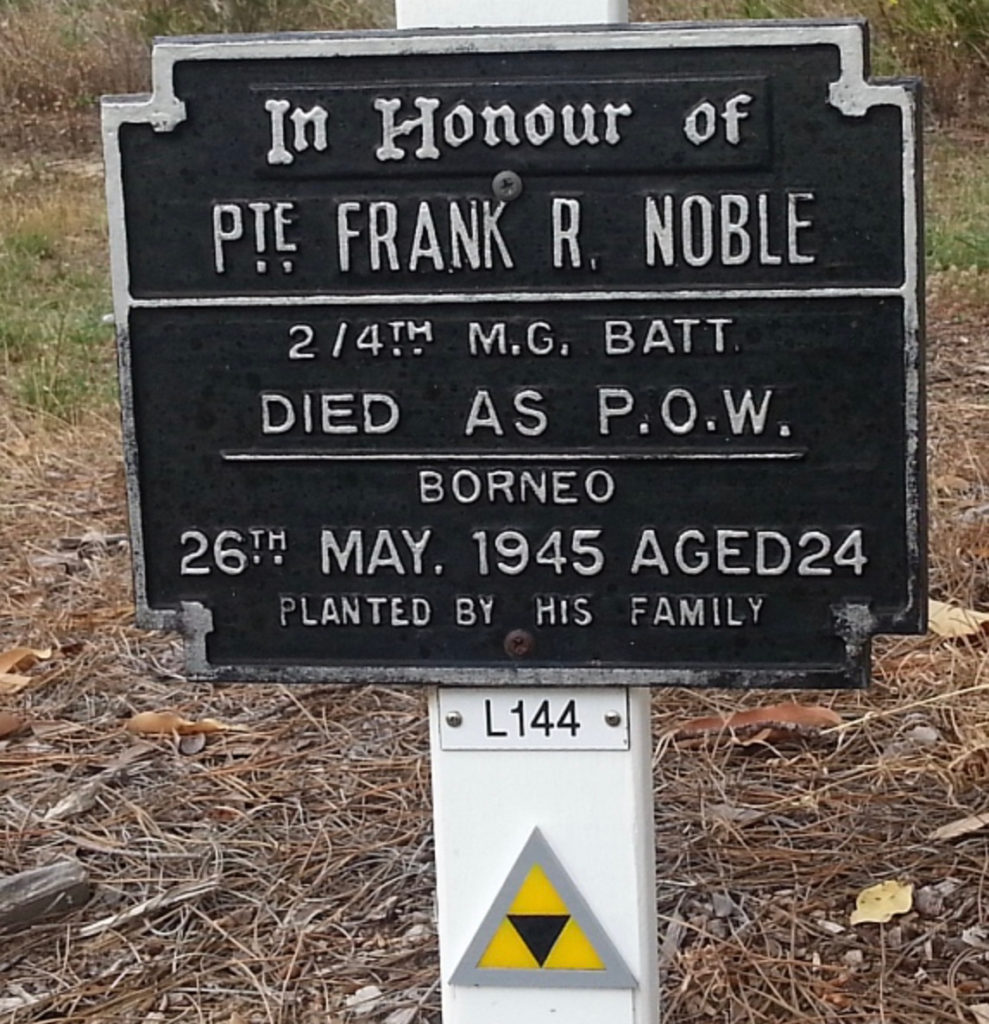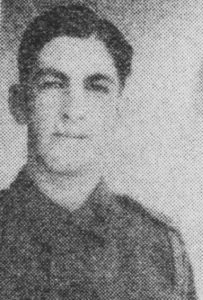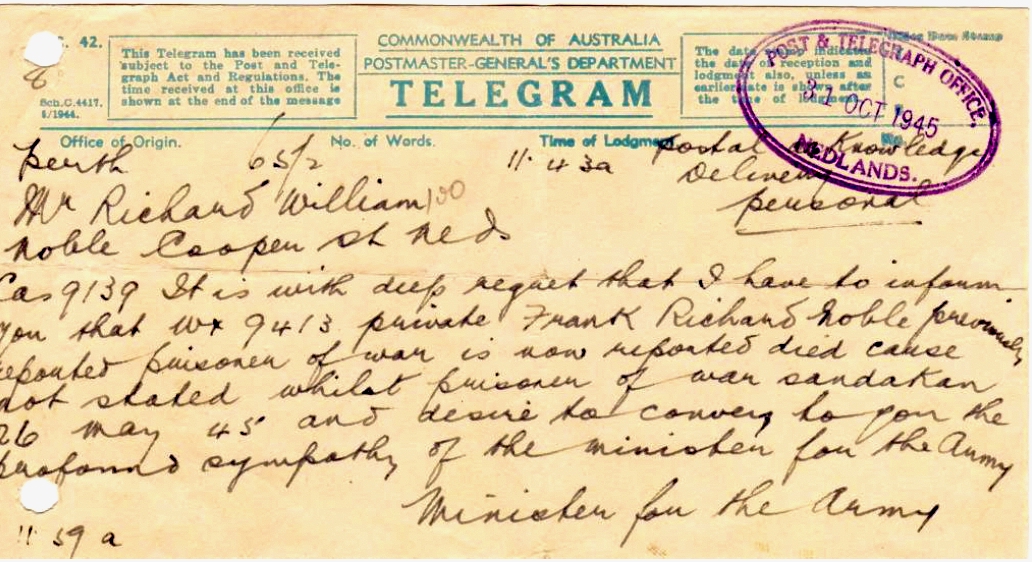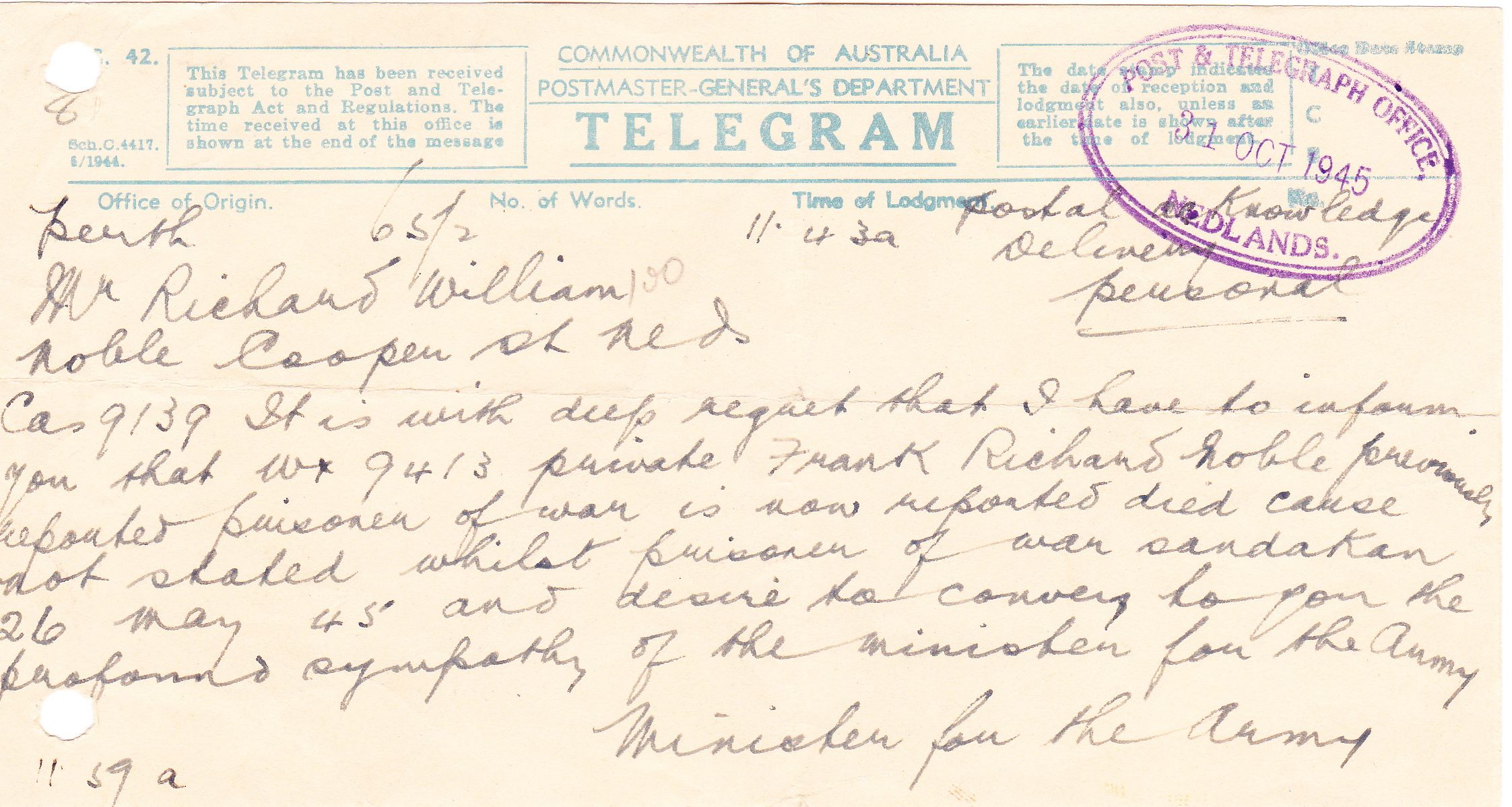The Soldier's Details

- Surname:
- Noble
- First Name:
- Frank Richard
- Rank:
- Private
- Regimental #:
- WX9413
- Classification:
- Rangetaker
- Company:
- ‘B’ Company, No 7 Platoon
- Enlisted:
- 28.11.1940
- DOB:
- 7.04.1920
- Place of Birth:
- Perth, Western Australia
- Father's Name:
- Richard William Noble
- Mothers's Name:
- Kathleen May Noble (nee Kildea)
- Religion:
- Church of England
- Pre-war Occupation:
- Clerk
- Memorial:
- Epitaph, Labuan Memorial, Panel 19, Age 25.
- Singapore:
- Selarang Camp and Barracks Changi
- Force:
- 'E' Force Borneo
- POW#:
- 1/8831 & 1843
- Cause of Death:
- Malaria
- Place of Death:
- Sandakan No1 Camp
- Date of Death:
- 26.05.1945
General Description
Photo taken with nephew, day 2/4th absconded from ‘Aquitania’ at Fremantle. Frank’s last day in Australia.
He was however, successful in reboarding his ship prior to ‘Aquitainia’s’ departure 16 Feb 1942 and rejoined 7 Platoon, ‘B’Coy.
Noble had enlisted AIF 28 Nov 1940 and later joined 2/4 MGB training as a Rangetaker.
Please read about ‘E’ Force Burma and Sandakan
WA. Paybook photograph, taken on enlistment, of WX9413 Private Frank Richard Noble, 2/4th Machine Gun Battalion, Australian Infantry. He was one of over 2000 Allied prisoners of war (POW) held in the Sandakan POW camp in north Borneo, having been transferred there from Singapore as a part of E Force. The 500 Australian and 500 British POW’s who made up E Force, left Changi on 28 March 1943, on board the S.S. DeKlerk arriving at Berhala Island (adjacent to Sandakan Harbour) on 15 April 1943. The POW’s were held there until 5 June, when they were taken by barge to Sandakan. The next day they were transferred to the 8 Mile Camp, which was about half a mile from the B Force compound. Private Noble, aged 25, died as a prisoner of the Japanese on 26 May 1945. He was the son of Richard and Kathleen May Noble, of Perth, WA. He is commemorated on the Labuan Memorial Panel 19. (Photograph copied from AWM232, items 4 and 5. Personal information from the Commonwealth War Graves Commission Database.)
Hale School Memorial
Plaque No 122:
Frank Richard Noble
Entered Hale School 1934
Frank entered Hale School in 1934 from Crawley.
After the outbreak of the war he joined the 2/4th Machine-Gun Battalion in November 1940 and after training at Northam was sent with his unit to Adelaide and then to Darwin. The battalion eventually reached Singapore on 24 January 1942, as the Allied forces were rapidly retreating before the Japanese advance. Singapore was surrendered by the Allies several weeks later.
After some months in Changi, he was taken to North Borneo as a member of the “E” Force prisoner-of-war labour contingent working around Sandakan.
As the war drew to a close the Japanese began a series of force-marches from Sandakan to Ranau. Prisoners, suffering from disease and malnutrition, had to walk 200 kilometres through inhospitable, tropical terrain across the mountains to Ranau. Only six men, of the 2,500 prisoners who were forced to participate, lived to tell the tale. One of those who perished was Frank Noble.
He died on 24 May 1945. He was 24 years of age.
Today the Frank Noble Systems Workshop, part of the Hale School Peter Wright Technology Centre at Hale School, has been dedicated to the memory of Frank by his family.
Below: an official notification of Frank’s death (with little information – families were provided no further information than what is included below. A terrible ‘sentence’ for families to live with).

NOBLE, Private, FRANK RICHARD, WX9413, A.I.F. 2/4 M.G Bn., Australian Infantry. 26 May 1945. Age 25. Son of Richard and Kathleen May Noble, of Perth, Western Australia. Panel 19.
Labuan Memorial, Malaysia.
Frank had an older brother Richard Maxwell Noble and two sisters Edna who married Alec Gregg and Molly who married Peter Stuart-Smith.
Frank’s mother Kathleen died in 1957 and his father in 1959.

Kings Park Honour Avenue.
Frank’s father Richard William NOBLE
‘The growth of Richard Noble & Company and Western Australia are interwoven, with the business having created new communities and leaving a lasting impression on the state for the past century.
The man who gave his name to the company, Richard William Noble, was born in Bath, England, in May 1882 and initially migrated to Melbourne. He returned to Australia from the Boer War in 1902, landed in Perth, and stayed.
For a decade, Noble served with WA Trustees and Executors but then branched out on his own, establishing Richard Noble & Company in 1913 and setting up his own city office in the basement of the WA Trustee Building at 31 Barrack Street.
The main focus of the business was real estate and establishing a name as a leading estate agent, but the young entrepreneur was also one of the first registered insurance brokers in Western Australia.
Business prospered after WWI and Noble managed to successfully steer the company through the difficult times of The Great Depression and WWII.
After the war, Noble moved into semi-retirement and, in 1946, entered into a partnership with his son-in-law, Alec Gregg.
Alexander (Alec) Longmuir Gregg was born 1904 in Belfast and migrated to Adelaide aged just 25. Within a few years, in 1932, he had married Edna Noble in Adelaide and welcomed a son, Michael.
With the outbreak of WWII, Gregg enlisted in the Royal Australian Air Force and his first posting after commissioning was Singapore. He was lucky to escape to Java after the fall of Singapore, eventually finding safe haven in Fremantle and a permanent home for his family in Perth.
Upon his discharge from the air force, Gregg’s career took a very different direction when he joined Richard Noble & Company. It wasn’t long before the company’s founder entered full retirement and his son in law assumed the role of managing director.
The business prospered under Gregg’s guidance with new estates at Bicton, Maylands, Bayswater and Mt Lawley taking shape until his premature death in 1963. He was aged just 59.
The tragic early death of his father thrust Michael Gregg into the top job – obviously with less-than-ideal preparation and certainly no managed transition period.
The third generation for any family business can be dysfunctional and many don’t survive, let alone prosper. Michael Gregg defied the odds. Under his leadership, the company grew a quality land bank for major stakeholders Gold Estates Holdings and The Adelaide Steamship Company, and also established a number of successful residential and commercial development syndicates.
During Michael Gregg’s time as managing director, the company established and developed some of Perth’s most successful residential estates, including Waterford, Leeming, Bull Creek, Beaumaris and Quinns Rocks.
The dynasty would continue. In 1986, Michael Gregg’s eldest son David joined the firm, followed by Alex in 1993. When Michael Gregg entered a well-earned retirement in 1996, Alex became managing director – the fourth generation to take on the position at Richard Noble & Company.’
Camp Locations:
- Selarang Camp Changi - Singapore
- Sandakan - Borneo ***
- Lintang Officers Camp, Kuching - Sarawak







